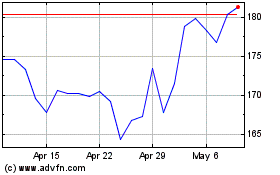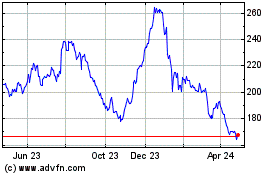By Andy Pasztor and Andrew Tangel
Potentially hazardous wiring inside Boeing Co.'s 737 MAX jets is
the latest flashpoint between U.S. and European regulators and a
further complication in the grounded fleet's return to service,
according to people familiar with the details.
Technical experts at the European Union Aviation Safety Agency
want certain electrical wires relocated to reduce what they say are
dangers from potential short circuits, which in a worst-case
scenario could disrupt flight-control systems, according to these
people.
In addition to the Federal Aviation Administration's ongoing
safety review of proposed fixes to the MAX, the European agency is
independently vetting such changes.
But engineers at the Chicago plane maker and high-ranking FAA
managers, including the agency's top safety official, contend
moving the wiring isn't necessary, one of these people said. Boeing
hasn't yet submitted its formal recommendation, though the issue is
headed for a decision in the next few weeks by FAA head Steve
Dickson.
The disagreement over whether to take action on the wiring,
which hasn't been reported before, has prompted the FAA to hold off
scheduling a key certification flight for the MAX. It also
highlights the emergence of a series of new technical challenges
and delays confronting the Chicago plane maker as it strives to get
the MAX back in the air world-wide. The planes have been grounded
since last March, following two fatal crashes that killed 346
people.
The planes are expected to gradually start resuming commercial
flights sometime in the summer, with major U.S. carriers having
removed them from schedules until June.
On Saturday, the FAA released a statement saying Boeing recently
informed the agency "about concerns associated with the location of
wiring in certain areas of the MAX." Since then, according to the
statement, "the FAA has closely monitored the company's analysis
and how the issue might affect the ongoing certification efforts."
The wiring concerns were reported earlier by the New York
Times.
Reiterating earlier statements, the FAA said the MAX will be
approved to carry passengers again "only after our safety experts
are fully satisfied that all safety-related issues are
addressed."
A Boeing spokesman said the company is cooperating with
international regulators on a thorough certification process, "and
we are working to perform the appropriate analysis." He said, "It
would be premature to speculate as to whether this analysis will
lead to any design changes."
A spokeswoman for EASA, which also hasn't submitted its final
position to the FAA, declined to comment. The issues still could be
resolved with a compromise, but Boeing's priority at this point,
according to some of the people familiar with the details, is
avoiding any wire modifications.
The wires, which help control movable panels on the tail and
power other systems, may be too close to each other in a dozen
locations from the rear of the aircraft to the main electronics
compartment beneath the cabin and behind the cockpit, according to
the people familiar with the issue.
A short circuit, or "arcing" of electrical current between
wires, could cause control problems for pilots that the FAA
characterizes as hazardous or in some cases even catastrophic,
according one of the people briefed on the details.
EASA and FAA technical experts, along with some other FAA
officials responsible for certifying aircraft designs, have taken
the position that safety rules require wiring modifications in such
instances, this person said.
The relevant international rules relate to safety enhancements
put in place more than a decade ago after an in-flight fire caused
a Swissair jet to plunge into the water near Nova Scotia in 1998,
killing all on board.
The current concerns about potential wiring problems stem from
Boeing's analysis of how short circuits could cause problems with
some flight-control systems, and how quickly pilots could react to
those emergencies.
Since the two fatal crashes, safety regulators have been
reassessing certain MAX flight-control systems, changing software,
adjusting related computers and modifying pilot training.
Last month, industry and government officials revealed the
latest software glitch, a problem that prevents the jet's
flight-control computers from powering up and verifying they are
ready for flight, and said Boeing was working to resolve it.
Addressing the wiring issues would pose tough logistical and
financial hurdles. How the agency mandates fixes may depend on who
owns the aircraft, according to another person familiar with the
details. The FAA may require Boeing to fix wiring on approximately
400 undelivered aircraft now in storage at airfields dotting the
Puget Sound area, this person said.
For planes previously delivered to carriers, the agency would
likely perform a risk analysis to determine whether the wiring
should be repaired either before the planes fly again or during
routinely scheduled maintenance, this person added.
Relocating the wiring bundles would take roughly two weeks per
plane, according to industry and government experts. Such fixes
could be performed at the same time as software and training
updates, depending on available manpower, to try to minimize
additional delays.
Write to Andy Pasztor at andy.pasztor@wsj.com and Andrew Tangel
at Andrew.Tangel@wsj.com
(END) Dow Jones Newswires
February 01, 2020 23:11 ET (04:11 GMT)
Copyright (c) 2020 Dow Jones & Company, Inc.
Boeing (NYSE:BA)
Historical Stock Chart
From Mar 2024 to Apr 2024

Boeing (NYSE:BA)
Historical Stock Chart
From Apr 2023 to Apr 2024
